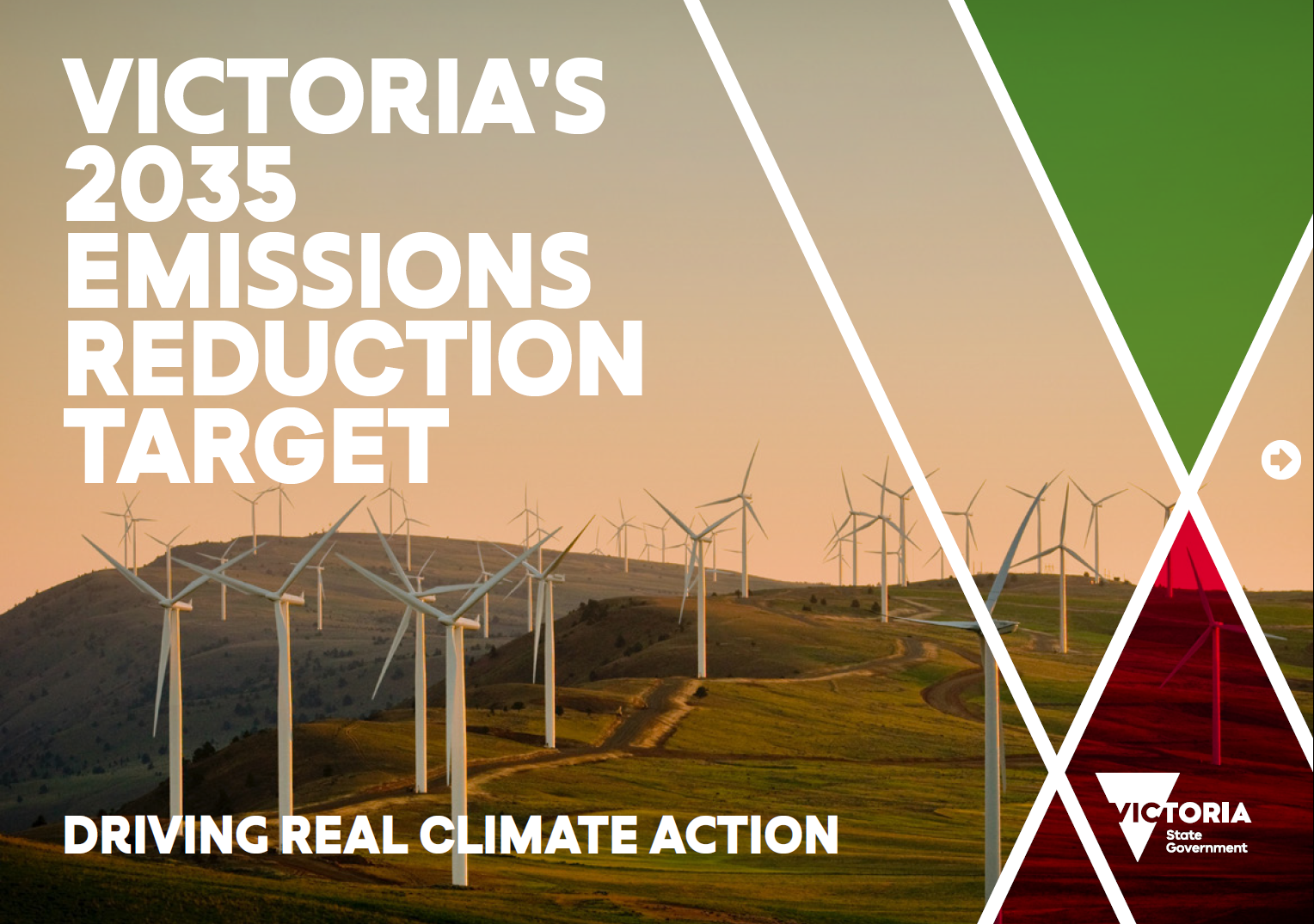Victoria’s climate action targets
Victoria has set in law world-leading targets to cut the state’s greenhouse gas emissions and achieve net zero emissions by 2045.
The government confirmed Victoria’s newest target, for 2035, in May 2023.
Driving real climate action
Victoria's 2035 Emissions Reduction Target (PDF, 3.4 MB): Victoria’s new 2035 target and key emissions reduction policies.
Victoria's 2035 Emissions Reduction Target - accessible (DOCX, 463.8 KB): Victoria’s new 2035 target and key emissions reduction policies - accessible version.
Victoria’s climate action targets
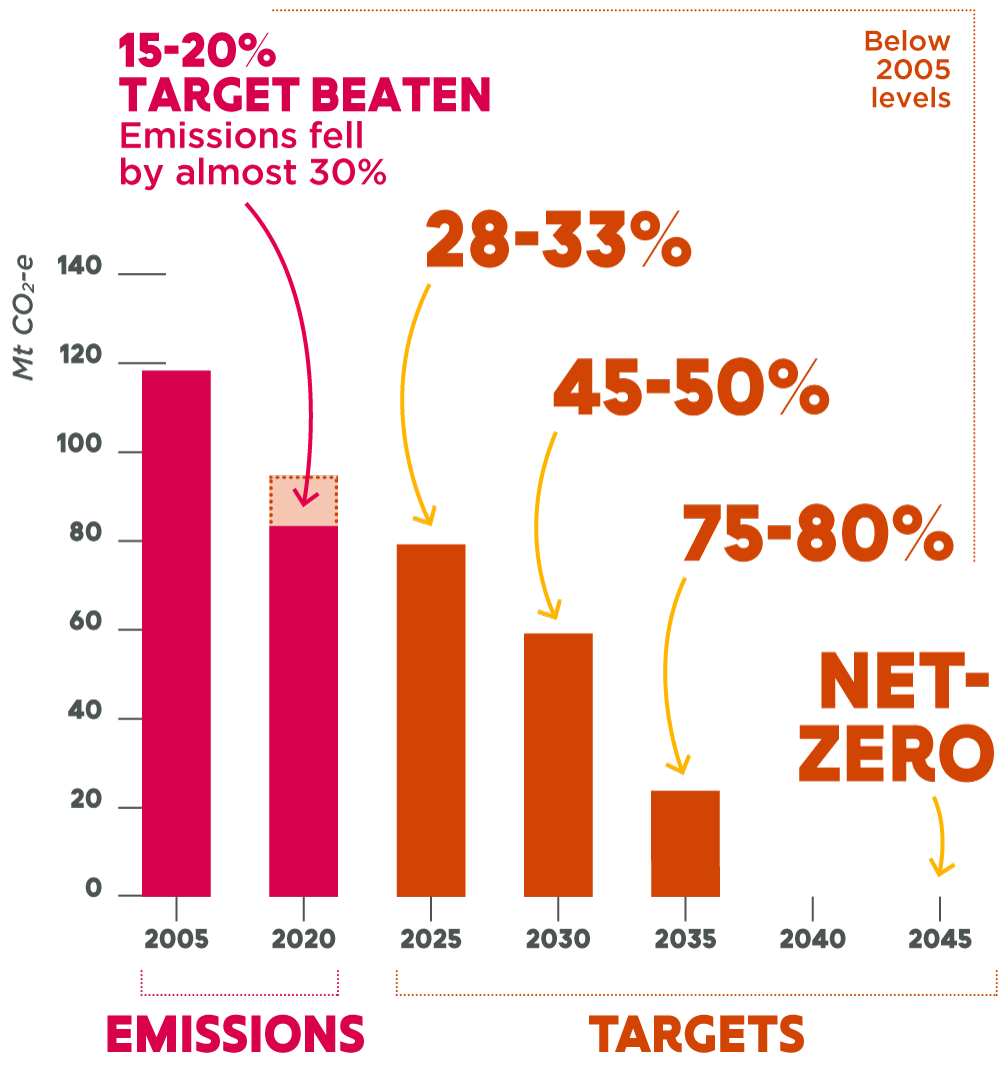
Victoria was one of the first jurisdictions in the world to put a net-zero emissions target in law. The Government brought forward the commitment to achieve net-zero from 2050 to 2045.
Victoria beat its first target – to reduce emissions 15-20% below 2005 levels by 2020 – with a cut of almost 30%.
Building on this success, the Victorian Government has legislated interim targets that provide a clear path to net-zero emissions:
- 28-33% by 2025
- 45-50% by 2030
- 75-80% by 2035.
Victoria’s targets are all reductions below 2005 emissions levels.
Note: Victoria’s 2040 target will be set by 2028.
Benefits from climate action
Meeting Victoria’s targets will create new jobs, including in clean energy, land restoration, zero-emissions transport, and the circular economy.
It will also create significant benefits for the community and the environment including cleaner air, lower energy bills, and greater biodiversity.
Meeting Victoria’s climate action targets will benefit the economy. Victoria’s economy will be $63 billion bigger from now to 2070 with our targets and strong global climate action. Strong targets will help attract part of the estimated $US130 trillion of global private finance available for the transition to net zero emissions. The targets will also help Victoria stay competitive as our key trading partners transition to net zero emissions.
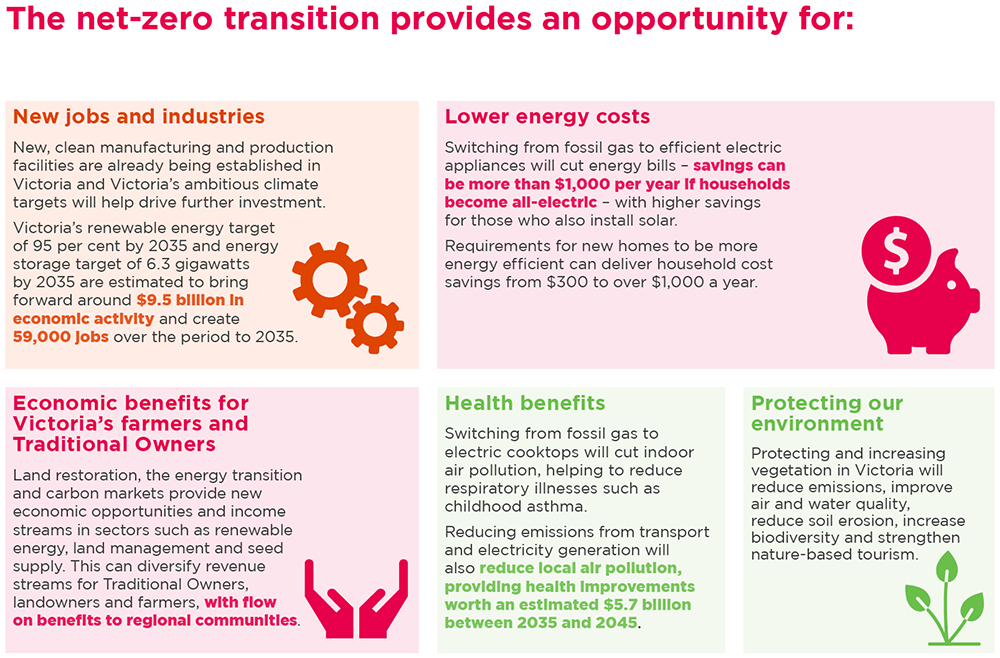
Meeting Victoria’s targets
Victoria’s targets are ambitious but achievable, building on trends and actions already underway. Victoria’s emissions have been falling since 2010. We beat the 2020 target and by 2021, Victoria’s emissions had fallen by 32% below 2005 levels.
Key actions the Victorian Government is already taking to cut emissions include:
- increasing and legislating the 2030 Victorian Renewable Energy Target (VRET) to 65% and setting a VRET new target of 95% renewable electricity generation by 2035
- legislating energy storage targets of least 2.6 gigawatts (GW) of energy storage capacity by 2030 and at least 6.3 GW by 2035 – the biggest targets in Australia
- legislating offshore wind targets of at least 2 GW of offshore generation capacity by 2032, 4 GW by 2035 and 9 GW by 2040.
- putting electricity back in the hands of Victorians by bringing back the State Electricity Commission (SEC)
- setting a target for 50% of new light vehicle sales to be zero emissions vehicles – powered by electricity, hydrogen and other clean new fuels – by 2030
- working towards the world’s first carbon-neutral pasture-based dairy farm.
The Victorian Government will continue to work with communities and businesses to build on these actions and meet the state’s climate action targets. Victoria’s Climate Action Act 2017 sets a framework to keep developing new policies to meet the targets, called sector pledges. The next set of pledges, for 2026-2030, are due in 2025.
Victoria’s climate action targets can be met with known technologies and solutions – and there is more than one way to get there. By 2035, all sectors of Victoria’s economy will be on their way to net zero emissions.
Illustrative pathway and key changes from today to Victoria’s 2035 target
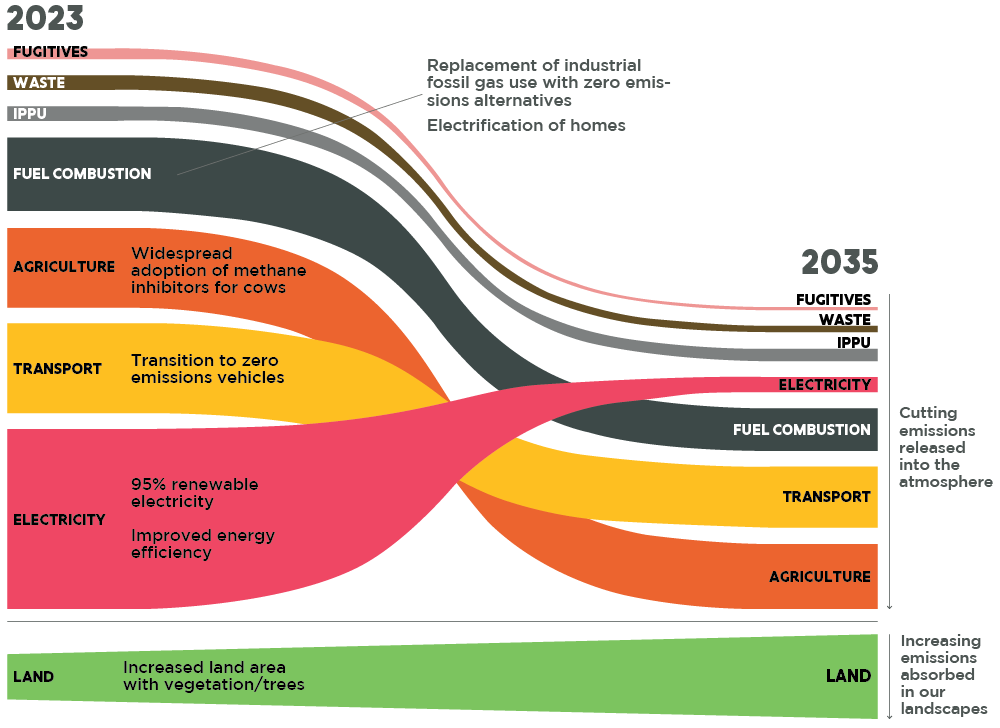
Want to know more?
Determination of Victoria’s 2035 target was informed by the following:
- Victoria’s 2035 Emissions Reduction Target: Supporting Analysis (PDF, 938.9 KB): a summary of the modelling exercises informing Victoria’s 2035 emissions reduction target
- Victoria’s 2035 Emissions Reduction Target: Supporting Analysis (DOCX, 552.1 KB): a summary of the modelling exercises informing Victoria’s 2035 emissions reduction target - accessible version
- Victoria’s 2035 climate action target (PDF, 5.5 MB): driving growth and prosperity: advice from the independent expert panel on Victoria’s 2035 target
- Victorian emissions budgets (PDF, 1.5 MB): independent analysis related to Victoria’s contribution to global efforts to minimise global temperature rise
- Victoria’s Climate Science Report 2019 (PDF, 6.7 MB): understanding the current and potential future impacts of climate change on Victoria. (Please note: Victoria’s Climate Science Report 2024 has now been published).
- Victoria’s greenhouse gas emissions (PDF, 2.7 MB): understanding Victoria’s contribution to climate change
- Determination of the interim greenhouse gas emissions reduction target—2035 (PDF, 308.8 KB): formal determination under the Climate Action Act 2017
Independent expert advice on targets
By law, the Minister for Climate Action must seek independent expert advice to inform the setting of Victoria’s climate action targets.
The expert advice must include:
- a recommended target
- indicative pathways to reach net zero emissions
- potential emissions reduction opportunities to achieve the target.
The experts must consider economic, environmental and social circumstances and impacts, and the latest climate science, national and global climate action, low-emissions technology and progress in reducing Victoria’s emissions.
2035 target independent advice
The Minister for Climate Action appointed an independent expert panel to provide advice on a target for 2035. The members were Martijn Wilder AM (Chair), Emma Herd and Tennant Reed. The Panel delivered its final advice on 1 March 2023.
The Panel recommended a 2035 target of 80% below 2005 levels.
The Panel’s recommended target for 2035 and indicative trajectory to net zero emissions

The Panel recommended that the Victorian Government focus on the following areas to achieve the 2035 target:
- a whole-of-economy climate action delivery plane
- electricity generation
- transition from gas
- built environment
- transport and forestry
- agriculture.
Read the Panel's advice
Victoria’s 2035 climate action target: driving growth and prosperity (PDF, 5.5 MB)
Supporting information
- Public consultation: results from online public consultation on the 2035 target held between 13 April and 5 June 2022.
- Terms of reference (PDF, 161.2 KB): the requirements of the Panel’s advice
The Panel also considered the evidence listed above.
Meet the panel
Martijn Wilder AM (Chair)
Martijn has deep expertise in law, finance and investment related to climate change and the clean energy sector. Martijn is Founder and CEO of Pollination, a global climate change investment and advisory firm. Before this he was head of the global climate law and finance practice at Baker & McKenzie.
Emma Herd
Emma has deep expertise in industry, banking, finance, policy and advocacy in the climate change arena. Emma is currently Partner for Climate Change and Sustainability Services at advisory firm EY. She was the former Chief Executive Officer of the Investor Group on Climate Change (IGCC) and non-executive Director of the Carbon Market Institute.
2025 and 2030 target independent advice
An independent expert panel advised the Minister for Climate Action on interim targets for 2025 and 2030. The Panel was chaired by the Hon Greg Combet AM, with members Dr Penny Whetton and Dr Lorraine Stephenson.
The Panel’s final report was tabled in Parliament on 6 June 2019.
Final advice
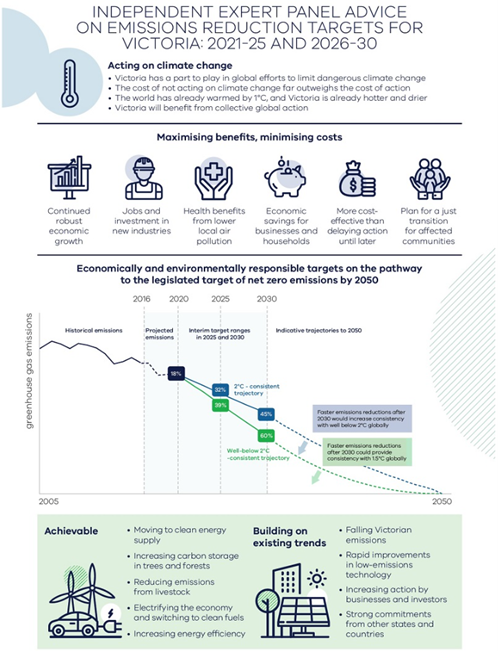
Supporting information
- Advice on applying Climate Change Authority emissions targets to Victoria (PDF, 515.4 KB)
- Advice on applying Climate Change Authority emissions targets to Victoria - accessible (DOCX, 132.6 KB)
- Economic impacts of timing of emissions abatement (PDF, 993.4 KB)
- Economic impacts of timing of emissions abatement - accessible (DOCX, 521.5 KB)
- Greenhouse gas emissions budgets for Victoria (PDF, 2.5 MB)
- Greenhouse gas emissions budgets for Victoria - accessible (DOCX, 2.3 MB)
Page last updated: 23/06/25
